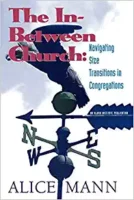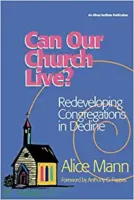[This article is part 2 of the series Crunch Time for Small Congregations.]
When churches and synagogues face new economic pressures, they sometimes consider merging. In this section we will take up three questions:
- What different forms can “merger” take?
- What is a “successful” merger?
- What have other congregations learned about merging that might apply to your situation? (“Best practices”)
What different forms can “merger” take?
A variety of different arrangements that might fall under this general heading of merger. Keep in mind that the same terminology isn’t used everywhere—you always have to define your terms for a particular conversation.
The first approach is sometimes called absorption. For example, a congregation decides to close its doors, but leaders want to bring a body of people and assets into the life of another congregation—one with a more robust institutional life, more viable programs, and an atmosphere of vitality. Even though it may be called a merger, one church or synagogue has essentially absorbed the other. The biggest challenge in this situation is pain—it is very hard for the weaker partner to make a decision to close the doors. But the receiving congregation also has decisions to make:
- When and how do we reach out to that struggling neighbor without seeming predatory?
- And how much accommodation should we make to the incoming group?
While many congregations see absorption as a “fate worse than death,” there is some evidence that this type of merger is most likely to result in a sustainable, longterm ministry. Church consultant David Raymond sampled twenty years of data from the Evangelical Lutheran Church in America to identify outcomes from the three types of mergers discussed here. You can view a chart showing his statistical findings at www.churchcollaboration.com.
In some cases, the “absorbing” partner offers to make changes that honor the legacy of the absorbed congregation. A clear-eyed assessment of the impact of such changes is essential; in some circumstances, a name change or shift in worship schedule could harm the vitality of the resulting entity. Instead, it may be wiser to carry forward one sacred object plus one or two meaningful practices from the absorbed partner—selecting items that will both honor that partner’s legacy and strengthen the fabric of the ongoing entity.
The second approach may be called continuation merger. (Some churches and synagogues use the term “consolidation” to emphasize the equality of the partners, while other systems reserve that term for the “rebirth” option described below.) In this model, two or more struggling congregations decide to combine their efforts. Denominational staff members often promote this approach—from their regional perspective, they can see how much it costs to maintain those separate facilities and staffs, and they can imagine what might be possible if the resources were pooled to build a stronger, more appealing program. But it entails many barriers:
- Potential partners may favor combining as long as the other partner comes to them. In effect, each wants to be the entity that absorbs the other, and is waiting for the other to flinch.
- The levels of readiness for a merger discussion may differ between the congregations. Think about what happens when two people are dating, but only one is prepared for a serious commitment. There is a lot of potential for misunderstanding, disappointment, and hurt feelings.
- Sometimes neighboring congregations have a long history of competition with each other, a strong “us and them” mentality. One church may have broken off from the other in some past conflict. Or they may have evolved on different sides of a theological controversy—high church vs. low church; or traditional vs. charismatic. Sometimes their local communities are competitive—it might be hard to merge where the two high school football teams are fierce rivals.
- And finally, if the denomination is seen as pushing the merger—or as having made the decision already—then resistance and resentment can stop things cold.
While there are certainly positive examples, David Raymond’s study suggests that this type of merger is the least likely to result in a vital and viable congregating going forward. (See the chart at www.churchcollaboration.com.) In this type of merger, negotiations tend to focus on maximizing continuity and minimizing pain for existing members. However, such continuity may guarantee that the downward trends precipitating the merger will continue at about the same rate—though perhaps now from a higher baseline of membership and financial reserves. Many observers report that attendance often settles out at the attendance level of the largest partner prior to the merger.
A third type might be called the re-start or rebirth merger. The emphasis is less on continuity with the past than on creating something new, fresh, and different. Both (all) the constituent congregations mark a definite ending which may include
- Legal dissolution of their corporations;
- Moving to a different location (with a new or new-to-you building), or building a brand-new facility together on an existing site;
- Relinquishing all the previous names (rather than stringing them together;)
- Bringing in new clergy leadership;
- And—perhaps most important—organizing the entire program around a new sense of purpose or mission that addresses the realities of the surrounding community in an effective way.
Raymond’s study suggests that the “fresh start” quality of these mergers makes them more vital and sustainable than the typical continuation merger. (See the chart at www.churchcollaboration.com.)
What is a successful merger?
Regardless of the form, what would be the hallmarks of a “successful” merger? In my role as a consultant, what do I see myself working toward when congregations ask me to help them merge? I would say that I am trying to help congregations achieve effective and mission-oriented mergers. Effectiveness would be measured by asking these kinds of questions:
- Is the process orderly and transparent?
- Do the partners put all their cards on the table—complete and accurate information about their situation?
- Are differences worked through, openly and creatively?
- Is the merged entity a healthy, functional organization?
- Has the early sense of “us” and “them” been transformed into a strong, new “we”?
These are very important outcomes to work toward. But effectiveness is only half the equation. A merged congregation may still continue down the same path of longterm decline. In that case, merger ends up being a way to buy a little time, or to shore up an eroding foundation for a few more years.
Unfortunately, some mergers produce an even more inward-looking church or synagogue. Blending the communities can become the primary mission—once the merger has taken place, all the available energy goes into negotiations about which candlesticks or torah scroll we will use for the major holy days this year.
When working toward a mission-oriented merger, success would be measured by a different set of questions:
- Does the merged congregation have a fresh sense of identity and purpose? Sometimes this is symbolized by a new name—not just a blend of what came before, but a name that captures the new intention, the new commitment of this faith community.
- Are people telling a new story about themselves? Not the old lament about decline, but a fresh story—focused on today and tomorrow—with some excitement about what this church can do, what this synagogue can be.
- Does that new story have legs? Are congregants already doing some things together that neither congregation ever did before? Are they already learning new ways of practicing their faith? Are they already moving outward to meet people and situations that they didn’t touch before?
- And, is the merged entity addressing the demographic and cultural challenges head on? For example, instead of just complaining about Sunday morning soccer, has the new entity made a clear decision about how it will respond to that trend? In that situation, one church might create radically flexible programs for children and youth, while another might do the exact opposite—identify itself as a high-commitment faith community with firm gathering times, knowing that this won’t reach everyone but that it will make a huge difference in the life of any family that accepts the invitation. Either way, the new congregation is taking a clear stance toward a cultural challenge. While there’s no guarantee that their selected strategy will work, it does allow them to focus all their energy in one coherent direction—and that makes them much more likely to succeed.
What are some best practices for merger?
If we are seeking to create an effective and mission-oriented merger, what could help us get there? The following steps are ones to consider. For a discussion of these steps in relation to synagogues, see an article by Alice Mann and Bob Leventhal in the publication called Synergy. We are indebted to synagogue executive director Harvey M. Brenner, from Temple Har Shalom Warren, New Jersey, for many of the suggestions included here.
Step One: Explore all the other options first. Merger is a strategy that brings dramatic—and in some ways traumatic—change. As soon as this becomes apparent to members, they are going to ask, “Why do we have to do this?” and “Why aren’t we solving our problems some other way?” These are good questions.
It helps to start with the widest list of options, and explore them with some care before narrowing down the list. This is a place where the denomination can help. Rather than prescribing or promoting a specific strategy, help congregational leaders look at the whole list. This work can begin at an educational workshop, where lots of different congregations are represented, to create an open atmosphere and bring a wide variety of viewpoints into the room.
But local leaders can do the same thing—before or after identifying potential partners. They can insist that step one includes looking at all the options, and to involve the congregation in the conversation before the list gets narrowed down.
What options should be on the list? Merging and clustering should be there as two different approaches to co-operation and cost reduction. Some other options should be on the big list, too.
- Moving to a new location—to connect better to our natural constituency, who may have moved away from our area; to trade in an albatross building for one that fits us better today; or to be more visible to the religiously unaffiliated population in our community.
- Changing leadership. This is a sensitive matter, fraught with potential conflict. But merger is guaranteed to raise those leadership questions—there’s just no avoiding this issue if the congregation is going to take new steps toward vitality.
When I say “leadership,” I mean both clergy and lay leadership. There is a tendency for congregations to think that all problems would be solved if we had a “better” pastor or rabbi, and this is clearly not true. But it is true that clergy with the appropriate gifts and energy level can make a big difference. If this question is being avoided, merger talks are not a very good vehicle for confronting it—the merger angle will only make it messier, and more confusing. Find a respectful and principled way to put the leadership issues on the table first. Once church leaders are discussing this frankly, within proper channels, merger may still turn out to be a good option to explore. Mergers tend to work best when all the partners join together to choose new clergy for the new entity. - Closing our doors now. This is the option of a holy death. Instead of expending time, money and energy on “making things work,” it can be a relief to ask whether it might be time to stop—while we can still celebrate all that has been in the past, and while we still have resources to devote to ventures that fit our deepest values. As we already saw, making this decision sooner rather than later might mean bringing a substantial body of people and money to another congregation that most of us will now join. Or, if members will be scattering in many different directions, it might mean making a bequest to some religious or social cause of great meaning to the congregants—some purpose that would be a worthy expression of all the past sacrifice and commitment people put into this synagogue or church. This can help a congregation to feel they are ending strong, and leaving a significant legacy.
- Continuing on the same path we are on now. This should always be on the list, because it is the default option anyway, the one people will mentally compare other options against.
You’ll notice I did not say, “Keep things the way they are now.” In a declining situation, things will not stay the same—they will get progressively worse. I usually ask, “If you keep doing what you are doing now, how long do you have?” Often, the treasurer has a pretty precise answer to that question—but no one has dared to ask it, at least out in the open. Confronting this information squarely will help the discussion of any other option to go better.
Sometimes, as sad as it is, people actually feel relieved that we are finally admitting what we all knew or feared to be true. If the news looks dire, there will be grief to deal with—but here it can be addressed directly, and not tied up in complicated merger proposals. William Bridges’s advice on transitions can be very helpful here.
So, the best preparation for merger talks is to work through this whole list—and maybe some other options as well. Partners that have taken this step will come into the talks clearer about their motivations and more realistic in their expectations. They will be better prepared for the level of change merger will entail.
Step Two: Assess our own strengths and liabilities as a potential merger partner. If the previous step has surfaced “merger” as an option you want to explore, take a sober look at yourself as a congregation. In the ideal case, you have already confronted the financial realities in the previous step, and you have started to think about what kind of leadership you may need at this stage of your life together. Now there are some additional questions to consider, as you create an honest and balanced congregational profile:
First, how healthy are the patterns and dynamics of your congregational life? For example, how well does your congregation
- Build a team relationship with pastors or rabbis?
- Handle conflict, difference and change?
- Face difficult facts?
- Make room for the newcomer, at all levels?
- Keep power and influence out in the open, where all can see and participate in the decision-making?
- Handle anxiety when things seem to be going wrong?
- Maintain a healthy relationship with your denomination or movement?
- Manage tensions among different generations or subgroups?
- Express generosity and social concern beyond your own walls?
Second, what would merger mean for our current staff and lay leaders?
- What formal agreements, or denominational requirements, do we currently have with clergy and other staff?
- What ethical responsibilities would we have if we decided not to continue with present staff members?
- Which lay leadership roles would be likely to change or be eliminated in a merger?
- How prepared are the incumbents (in staff and volunteer roles) to work with the change and uncertainty that merger negotiations would bring?
- How deep is our leadership “bench” when it comes to change management, and sensitive handling of personnel matters?
Step Three: Create a “Merger Exploration Committee.” Once an honest profile has been completed, and endorsed by congregational leaders as an accurate picture, each potential partner may be ready to create a “Merger Exploration Committee.” This is not a decision-making body. Its only purpose at this stage is to assess compatibility with potential partners, and to bring back a recommendation about whether to start any formal merger negotiations. Setting it up this way means that each congregation can look forward to a formal “check-point”—a time when leaders and members will pause to deliberate about what they have discovered. This helps everyone manage the anxiety that the process naturally generates—members and staff feel assured that nothing will happen suddenly, before they have a chance to weigh in.
Step Four: Negotiate the merger. Now, instead of an exploration committee, each congregation has a negotiating team. There will probably be some carry-over from the previous group, but the negotiating team will probably be a smaller body with a more focused set of skills and gifts. This team needs process awareness and peopleskills; expertise in negotiating agreements; a high capacity for discretion; and a reputation for wisdom and integrity in their home congregation.
During the negotiation stage, the teams need to have clear guidelines about communication—what will be communicated, when, and how. Many of the details of the discussions should be held in confidence within the teams. It’s not helpful to recount all the reactions during the conversations—that’s too much information—it can generate problems that could kill a promising relationship. On the other hand, the negotiations should not be a black hole—that will provoke anxiety and suspicion. So the teams need to develop agreed communications—flowing regularly throughout the process—in much the same way that a clergy search committee would proceed.
Step Five: Deliberate. If the negotiation process is fruitful, the two (or more) merger teams will work out a merger proposal to bring back to their home congregations. The deliberation process should be very well-defined.
- A clear beginning, where the proposal is presented and explained thoroughly. This probably needs to happen several times so that as many members as possible hear directly from the negotiating team, rather than from second-hand accounts. At the same time, full printed information should be circulated, so that people who miss the presentations can see clearly what is being considered.
- A clear middle—a period of time when each congregation can live with the proposal, and discuss it in an orderly way.
- A clear end—at the beginning, announce the date for a vote, who will participate, and what the procedure will be. Is is only the board, or the whole congregation who will be voting? How will the list of qualified voters be compiled? What does it take for the motion to be adopted—a simple majority? A certain percentage? It may be best for the participating congregations to deliberate on the same day, in order to ensure that each party reaches its own conclusion.
- If the denomination must give approval, show this step of the process right from the beginning, so people are not surprised.
- The merger team needs to have a communication plan all prepared before the day of deliberation. How will the outcome be communicated?
Step Six: Set a definite date for the change to take effect. Leave some time between now and then for both emotional and technical work to be completed.
- At the emotional level, the congregations need a way to discuss and reflect upon the outcome of the deliberations—whatever they were.
- But there will also be legal articles to draft to implement the negotiated agreement, and other kinds of business to be completed.
Step Seven: A well-planned weekend of special events to celebrate and implement the change.
Finally, I would offer a couple of general points about the merger process. First, it helps to have one or more outside resource people working with the congregations throughout the process. And second, a merger proposal rejected is not automatically a failure. If a merger resolution fails in one or more congregations, there may still be significant forms of co-operation that can go forward, powered by the vision and the new relationships that have been established during the process.
[Return to the series Crunch Time for Small Congregations.]
Alice Mann is a leading consultant, educator, and author in the field of congregational development, whose work has focused on strategic planning, breaking through size plateaus, creating new pathways for small and struggling churches, and helping congregations to discern and care for the “soul” of their local community. Mostly retired from consulting and teaching, Alice is an active member of a small, engaged urban congregation and also offers leadership for faith-based community organizing in her region. She occasionally accepts one-time conversations with former clients and other church leaders on issues close to her heart.
Books by Alice Mann





